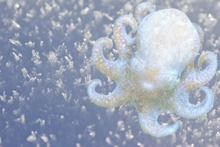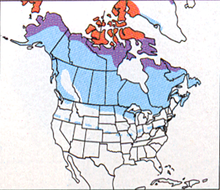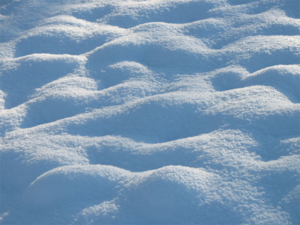Northern Taiga Octopus
| Northern Taiga Octopus | |
|---|---|
An immature Northern Taiga Octopus (1.5" / 3 cm). | |
| Scientific classification | |
| Kingdom | Animalia |
| Phylum | Mollusca |
| Class | Cephalopoda |
| Order | Octopoda |
| Family | Octopodidae |
| Genus | Octopus |
| Species | O. sylva borealis |
| Diversity | |
Winter range: blue, Summer range: red, Year-round: purple | |
| Specifications | |
| Length | 14" (36 cm) mantle length, tentacles 10-24" (25-61 cm) additional |
The great Northern Taiga Octopus is a beautiful sight as it perches upon a snowy knoll, or as it moves just beneath the surface of the snow cover, undulating gracefully and leaving a double track punctuated by indentations (from using its siphon to ease its passage in the snow). Unlike the Pacific Northwest tree octopus, the taiga octopus is almost never seen in a tree, preferring the safety of the ground or other place where its exceptional camouflage abilities afford it both protection from predators and allow it to hunt its own prey. In the far north where it breeds, it depends largely on lemmings for food, although there have been recorded cases of social behaviour where small groups of taiga octopuses have brought down coyotes and young caribou. The size of the lemming population periodically changes (due to population explosions and subsequent epidemics), and it is the decrease in lemming numbers that is believed to trigger the social behaviour. In the winter, the octopuses migrate south, following the snow line. In the southern latitudes, they feed on the more plentiful rodents and small to medium-sized birds. The presence of rats and gulls that feed on refuse in urban areas has been seen to attract the Northern Taiga Octopus to the outskirts of cities.
Species Information[edit]
The Northern Taiga Octopus is a medium cephalopod with close-set eyes, ranging in colour from nearly pure white to grey-brown depending on its surroundings and mood. Females tend toward the larger sizes and are more aggressive. Males are smaller and generally shy away from contact. They are usually silent; on breeding grounds, they may produce a raspy whine by forcing air through their siphon under pressure. Its habitat is taiga, requiring high humidity or water. Animals of this species secrete an antifreeze protein simliar to the Polar Cod (Boreogadus saida) that allows it to survive on snow-covered ground. It prefers areas with cover, but females may hunt in nearly open ground, using their camouflage for both protection and stealth. The females generally lay 500-800 white eggs on a lining of snow, damp mosses and lichens placed under conifers or in crevices of rocky areas. It breeds in Alaska, and northernmost Canada, wintering across the continent as far south as the northern United States. Irregularly, it may winter farther south when the season is extreme. There are occasional sightings in Eurasia, but there is debate as to whether these are the same species.
Like all cephalopods, the skin of the Northern Taiga Octopus contains many chromatophores (colour cells) that the animal can control at will. In addition, it has the ability to change the texture of its skin at will. This affords the octopus superlative camouflage abilities in any terrain. Observations of this species have recorded that it is capable of mimicking even complex colours and textures that might be found in its harsh northern habitat. Females are capable of becoming nearly pure white, allowing them to hunt in snow-covered fields.
Ecological Competition[edit]
The Northern Taiga Octopus shares a similar ecological niche to the Hoop Snake, and encounters are somewhat common. This will usually result in the octopus using its ink to blind the snake while it flees and camouflages itself. However, either animal is capable of killing the other and mutual predation has been observed.
On the west coast of Canada and Alaska, the Northern Taiga Octopus may share habitat with the endangered Pacific Northwest Tree Octopus, although the latter is arboreal and they seldom come into conflict.
See Also[edit]
External Links[edit]
- Campaign to save the Pacific Northwest Tree Octopus [1]



